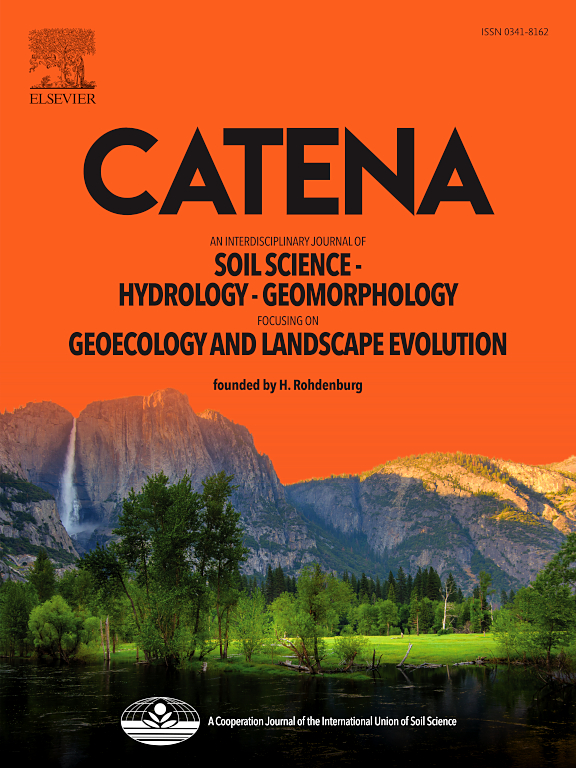Landscape evolution and chronostratigraphic correlations of the cave entrance depositional environments and palaeosols of the Gran Dolina unit TD10 (Sierra de Atapuerca, Spain)
IF 5.4
1区 农林科学
Q1 GEOSCIENCES, MULTIDISCIPLINARY
引用次数: 0
Abstract
Gran Dolina Unit TD10 is a sedimentary succession located at the cave entrance depositional environment of the Sierra de Atapuerca multilevel cave complex (Burgos, Spain). Its lithostratigraphic units include four archaeostratigraphic subunits (TD10.1, TD10.2, TD10.3, TD10.4) dating to the Middle Pleistocene, which have been the focus of numerous multidisciplinary studies. This research is based on the examination of large-format thin sections (14 x 6 cm) cut from monolith samples of undisturbed sediments, combined with field descriptions of TD10. We divide unit TD10 in three lithostratigraphic units: TD10a, TD10b and TD10c.
Our detailed description and interpretation of the TD10 microfacies classification is guided by facies models and sedimentary process of slope deposits. The primary findings support the identification of distinct sedimentary processes, illustrating the evolution of cave entrance talus scree deposits into stratified slope deposits. Field and microscopic observations of cave entrance deposits are closely integrated with palaeoecological reconstructions, particularly concerning the vanished middle Pleistocene soils of the slopes of Gran Dolina prehistoric site.
Additionally, analogies with other archaeological sites and soil formation processes provide insights into palaeosol profiles and the formation processes of the archaeological record. Finally, we discuss and formalize depositional and palaeoenvironmental units, correlating them with marine isotopic stages and substages using Bayesian chronostratigraphic modelling and TD10 palaeosols. Chronological uncertainties arise in TD10b between Bayesian dates and permafrost and (paleo-argillic) brown earths buried horizons, which are correlated with MIS 12 and MIS 11 in north-western Europe. TD10a Bayesian chronology aligns with MIS 9 in agreement with a interglacial palaeosol record. This research emphasizes the complexity of cave entrance stratigraphy and its pivotal role in reconstructing past environments.
西班牙阿塔普埃卡山TD10大多里纳单元洞口沉积环境与古土壤的景观演化与年代地层对比
Gran Dolina Unit TD10是位于Sierra de Atapuerca多层洞穴群(Burgos, Spain)洞穴入口沉积环境的沉积序列。其岩石地层单位包括4个考古地层亚单位(TD10.1、TD10.2、TD10.3、TD10.4),可追溯到中更新世,已成为众多多学科研究的重点。这项研究是基于对未受干扰的沉积物整体样品中切割的大尺寸薄片(14 x 6厘米)的检查,并结合TD10的现场描述。将TD10单元划分为TD10a、TD10b和TD10c三个岩性地层单元。以斜坡沉积的相模式和沉积过程为指导,对TD10微相分类进行了详细的描述和解释。初步发现支持了不同沉积过程的识别,说明了洞口泥质碎石沉积向层状斜坡沉积的演化过程。洞穴入口沉积物的野外和显微观察与古生态重建密切相关,特别是关于大多利纳史前遗址斜坡上消失的中更新世土壤。此外,与其他考古遗址和土壤形成过程的类比提供了对古土壤剖面和考古记录形成过程的见解。最后,利用贝叶斯年代地层模拟和TD10古土壤,讨论和形式化了沉积和古环境单元,并将它们与海洋同位素阶段和亚阶段进行了关联。在TD10b中,贝叶斯日期与永久冻土和(古泥质)棕地埋层之间存在时间上的不确定性,这与欧洲西北部的MIS 12和MIS 11相关。TD10a贝叶斯年代学与MIS 9一致,与间冰期古土壤记录一致。本研究强调洞口地层的复杂性及其在重建过去环境中的关键作用。
本文章由计算机程序翻译,如有差异,请以英文原文为准。
求助全文
约1分钟内获得全文
求助全文
来源期刊

Catena
环境科学-地球科学综合
CiteScore
10.50
自引率
9.70%
发文量
816
审稿时长
54 days
期刊介绍:
Catena publishes papers describing original field and laboratory investigations and reviews on geoecology and landscape evolution with emphasis on interdisciplinary aspects of soil science, hydrology and geomorphology. It aims to disseminate new knowledge and foster better understanding of the physical environment, of evolutionary sequences that have resulted in past and current landscapes, and of the natural processes that are likely to determine the fate of our terrestrial environment.
Papers within any one of the above topics are welcome provided they are of sufficiently wide interest and relevance.
 求助内容:
求助内容: 应助结果提醒方式:
应助结果提醒方式:


